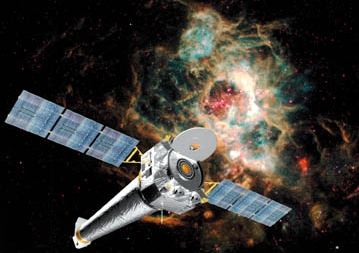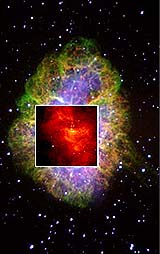| Chandra X-Ray Observatory | |||||
 |
|||||
|---|---|---|---|---|---|
| The third of NASA's Great Observatories for Space Astrophysics | |||||
| Chandra | Science | Spectrum | History | Resources | Great Observatories |
| Chandra X-Ray Observatory | |||||
 |
|||||
|---|---|---|---|---|---|
| The third of NASA's Great Observatories for Space Astrophysics | |||||
| Chandra | Science | Spectrum | History | Resources | Great Observatories |
X-rays from distant objects in deep space cannot be observed from on the ground because Earth's atmosphere blocks them. Only instruments placed above and beyond the atmosphere can measure the x-ray sky.
X-rays represent very high temperatures and x-ray astronomers study high-energy processes in the Universe. Such high-temperature processes represent a small fraction of the energy generated by ordinary stars like our Sun, but they can dominate the output of energy from supernova remnants, quasars, neutron stars and black holes.
Chandra gives scientists their first view of some of the most violent and energetic activities in the Universe. Compared with the red-green-blue visible light, which carry an energy of about 2 electron-volts and are seen through optical telescopes, Chandra sees energy ranging from 50 to 10,000 eV. That permits astronomers to photograph extraordinary activities taking place at faraway places across the Universe.
The astrophysics community is eager to use Chandra to answer thousands of questions about the Universe. For instance, observations planned by scientists at NASA's Marshall Space Flight Center include:

How hot is the Crab? In the summer of 1054, people in Japan and China witnessed an unusual display of fireworks in the summer sky. The Crab Nebula, as the display came to be named, was a new exploding supernova so bright it was visible in the daytime sky for nearly a month. Eventually, it faded from view and was not rediscovered until astronomers using new telescopes in the 18th century spotted it. Chandra allows astronomers to take the Crab's temperature.
The composite photo image at left shows a Hubble Space Telescope image of the heart of the Crab Nebula inset into a wider false-color visible-light image of the nebula. Chandra shows even finer details of the neutron star that powers the Crab Nebula's emissions.
Looking for pulsars in the fast lane. The discovery of the first magnetar in 1998 put the spotlight on a small class of stars called Anomalous X-ray Pulsars, or AXPs. A magnetar is a highly magnetized star. Chandra allows astronomers to add to human knowledge and understanding of magnetars.
Soft gamma repeaters. The 1998 magnetar discovery involved a small class of cosmic sources of high-energy radiation known as Soft Gamma Repeaters (SGR). The magnetar theory now suggests that SGRs may become AXPs before they fade from the scene altogether. Chandra observations will shed more light on AXPs.
Why did the supernova morph? Most objects in the sky have been pigeonholed into just a few of the hundreds of categories that classify stars, galaxies and other bodies. Sometimes an object changes colors, which requires closer examination. Cosmic chameleons are being examined more closely with Chandra.
The science plan. Chandra's scientific objectives inlude finding out exactly what goes on in the vicinity of black holes, clearing up the mystery of stupendous explosions called gamma-ray bursts, investigating cannibalism among stars, understanding the release of newly made chemical elements from stellar explosions, and discovering the origin of cosmic rays that rain on Earth. [Chandra photo album]
What if our Sun had a twin? New light has been shed on the question by a Chandra study of two stars bound together in a very tight binary system. Part of a star system known to astronomers as 44i Bootis, these stars orbit around each other so quickly that that they pass in front of one another every three hours.
44i Bootis.
Artist conception
Chandra X-ray Observatory Center
Click to enlarge
The 44i Bootis twins are only 42 lightyears from Earth in the constellation Bootes. That is relatively close in the vast distances of the Universe. Chandra looked at 44i Bootis for 59,000 seconds on April 25, 2000.
Astronomers used the strange alignment of these two stars whipping around each other to learn more about magnetic fields and outer atmospheres in stars like our own Sun.
Giant arches of hot ionized gas. Observers see the Sun -- at the center of our Solar System -- creating complex magnetic fields as it spins on its axis once every month. The magnetic fields confine giant arches of hot ionized gas that erupt from the surface of the Sun. Sometimes these eruptions flare out toward Earth and affect satellites orbiting above the planet and power grids and other human systems on the surface of the planet..
Astronomers think that rapidly spinning stars can produce magnetic fields different from those of our Sun. Unfortunately, the countless stars like 44i Bootis outside of our Solar System are too far away for our largest telescopes to see magnetic loops on the surfaces.
In an eclipsing binary, two stars circle fly around each other. The two-star system known as 44i Bootis is an eclipsing binary. Chandra peers out into deep space from its orbit above Earth.
Ebb and flow of radiation. The two 44i Bootis stars are aligned so that Chandra can capture images of the ebb and flow of radiation as the stars pass in front of one another. Using the well-known Doppler effect, astrophysicists were able to measure tiny changes in the wavelength of X-rays emanating from hot gas filling the magnetic field structures on the 44i Bootis twins.
By measuring changes in the Doppler shift, astrophysicists use Chandra to pinpoint where the radiation is coming from on the twin stars. It turned out to be not where many astronomers had expected it to be. In fact, most of the radiation from the 44i Booti stars comes from areas around their poles.
Doppler shift. Doppler is name of the effect that causes a siren to change its frequency as an ambulance approaches. The 44i Bootis stars are like our Sun in many ways. [how Doppler shift works]
Astronomers trying to understand the stars found it puzzling. They were surprised to see that a white spot on the larger star produces half of the X-rays from the two. By contrast, the X-ray active regions on our Sun are near the equator.
The new question is, how can the 44i Bootis twins produce such different patterns of X-ray structures when in a closely orbiting binary system?
Chandra Science Spectrum History Resources
Hubble Compton SIRTF Great Observatories Telescopes Deep Space
Search STO About STO Questions Suggestions Feedback E-Mail
© 2002 Space Today Online E-mail